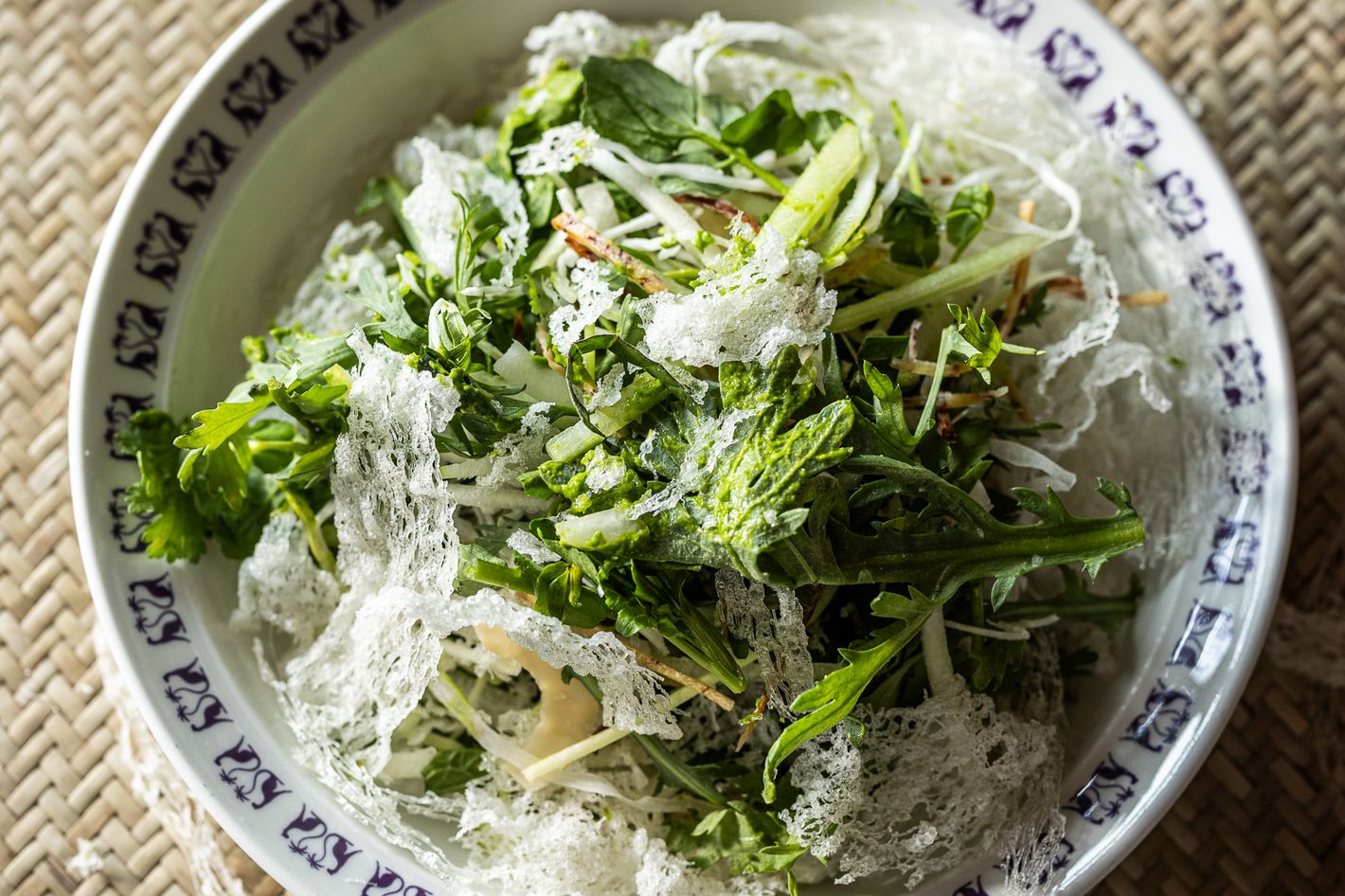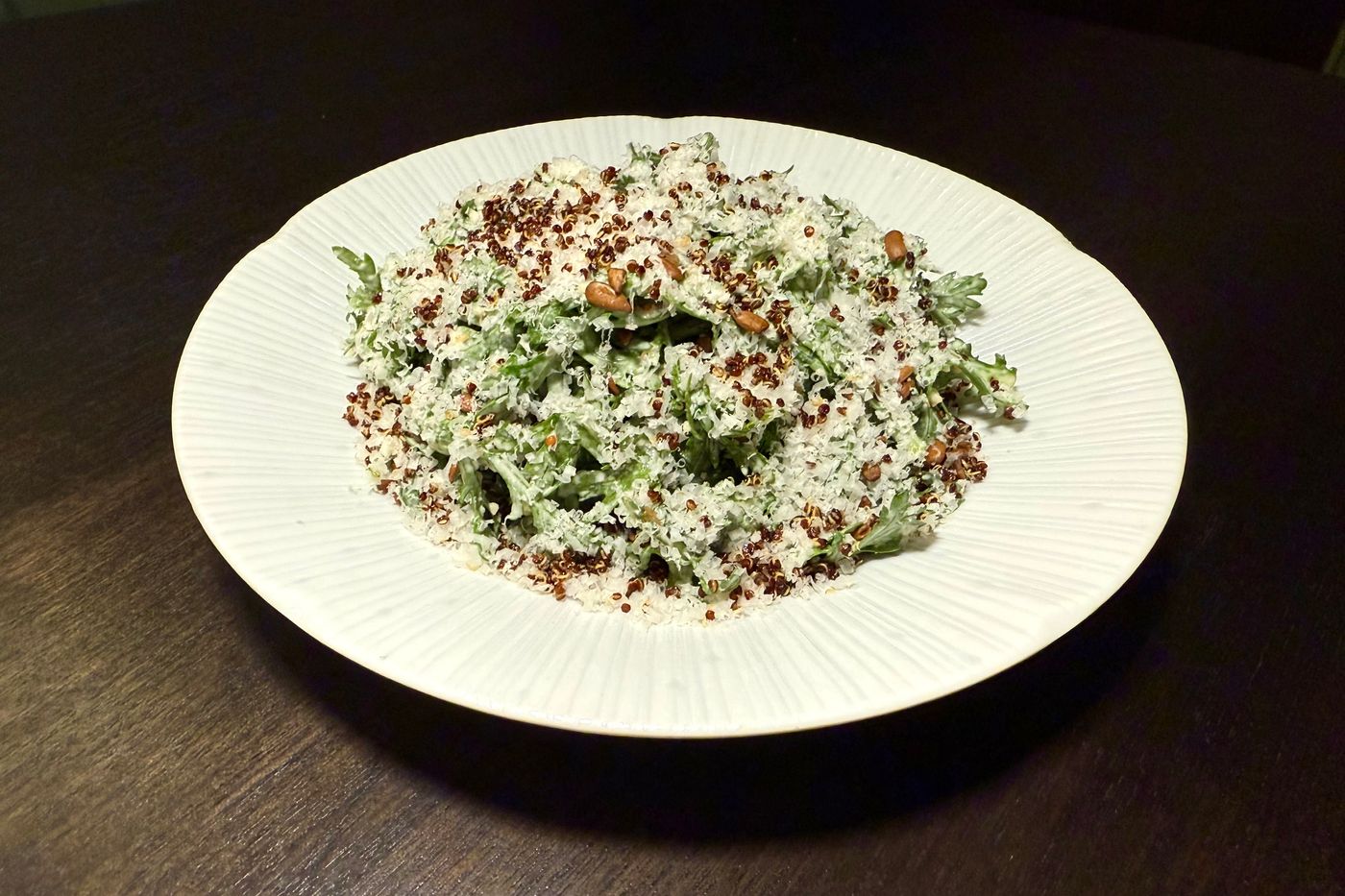when you want, where you want.
There’s a Fresh Green That’s Ready to Be Caesar’d
 Photo: Courtesy Twin Tails
Photo: Courtesy Twin Tails
No salad is more resilient than the Caesar, owing as much to its literal sturdiness as the flexibility that allows it to take all sorts of new forms: with kale or little gem, fortified with grilled chicken or salmon, turned into a wrap. The key tenets are creaminess, saltiness, and crunch. When chef Jessica Lee-An was developing a salad for the menu at Sae Ron, a modern Korean restaurant on the Lower East Side, she recalled the piles of chrysanthemum greens that her grandmother would forage from neighbors’ yards in Seoul growing up. Grandma cooked them — in a stew or hot pot, or blanched and dressed as a banchan — but the former Gramercy Tavern pastry chef wanted to represent both her Korean upbringing and American tastes, so her chrysanthemum Caesar salad at Sae Ron is an airy mound of frondlike chrysanthemum greens tossed in a classic anchovy-laced dressing before it’s topped with a snowfall of shaved Parmigiano-Reggiano and crumbles of toasted black quinoa and fried sunflower seeds. “It’s very herbaceous and refreshing — it’s almost like eating parsley crossed with a hint of cilantro with grassy and peppery notes,” Lee-An says.
She is not the only Asian American chef to tap the assertive taste and feathery texture of tender, young chrysanthemum greens for a salad, which classically were eaten raw only when they were in stolen bites from a platter of hot-pot fixings. (Eating chrysanthemum greens — or any leafy green — raw rather than cooked is taboo in many East Asian cultures, making the leap from hot-pot fixture to salad all the more surprising.)
“I always thought they were carrot tops,” says Craig Koketsu, the chef and partner at Twin Tails, an upscale Thai and Vietnamese restaurant in Columbus Circle. Growing up in a Japanese American family in San Jose, California, he and his family often ordered sukiyaki at restaurants to prepare tableside; chrysanthemum greens were always one of the components to be cooked in the bubbling pot, although he didn’t correctly identify them as such until much later in life.
Today, he tosses chrysanthemum greens with shredded cabbage, cucumber, apples, jicama, honeydew, pea shoots, basil, and avocado with a tamarind dressing in the Emerald Goddess salad at Twin Tails. They stand out not only for their sharp taste but for their distinctive appearance in this mixture, Koketsu says. While Don Angie, a sister restaurant owned by the same hospitality group, serves a chrysanthemum Caesar salad as a signature dish, Koketsu says his inspiration was the Canadian chef Susur Lee, who once made a slawlike salad at his New York restaurant Shang. And, of course, sukiyaki. “Chrysanthemum leaves wilted in that sweet sukiyaki broth with the noodles and everything is a taste memory that’s still ever present,” Koketsu says.
“As a kid, it was just eaten to satisfy your mom, but as you get older you really develop a taste for this bitterness,” says Patty Lee, the chef at Lei wine bar in Chinatown. She “kind of freaked out” the first time she bit into the leaves raw for the first time. Her Taiwanese parents would have sautéed even iceberg lettuce, and she’d only ever had chrysanthemum greens cooked. But she found that the distinctive flavor was about the same raw as when it was cooked, says Lee, yet the texture was more crisp.
At Lei, she dresses the freshest chrysanthemum greens she can find (that often means buying them from Lani’s Farm) with a vinaigrette made with rice vinegar and strong-brewed chrysanthemum tea before the salad is topped with shards of fried burdock root. Annie Shi, Lei’s owner, says her first bite of the salad was “transportive,” recalling both hot-pot meals and boxes of Vitasoy-brand sweetened chrysanthemum tea.
 Photo: Christine Yoo
Photo: Christine Yoo
A chrysanthemum salad has also been served at Bonnie’s, the modern Cantonese restaurant in Williamsburg, since it opened in 2022. The greens are tossed with whipped-tofu dressing and covered with blitzed-fried shallots for a bread-crumbish topping. Calvin Eng, the chef and owner at Bonnie’s, says he, too, had never eaten chrysanthemum greens raw until he tried the Caesar at Don Angie’s, which helped him see the familiar ingredient in a new light: “It’s a little medicinal but in a good way.”
According to Zoey Xinyi Gong, a dietitian and the author of The Five Elements Cookbook, the medicinal properties go beyond flavor: “Their functions include harmonizing the spleen and stomach and calming the heart Qi. In modern language, it means that they are good at helping us regulate fluid metabolism and calm us a bit when we feel irritated, impatient, and angry.” (She prefers her chrysanthemum greens blanched in bone broth and topped with tahini, soy sauce, and vinegar.)
For the chefs who covet the greens, it’s also helpful that they grow well in New York, especially this time of year. Christina Chan, founder of Choy Division farm in Chester, has been growing chrysanthemum greens for the past few years and distributing them to the 300-some customers of the Choy Commons CSA. She’s found that this vegetable grows best in cooler summer months and early fall, so her crop will be available in the coming weeks. And now she can give her customers some new advice on how to prepare them. “The biggest question we get is, ‘What can we do with them?’” Chan says. There aren’t a whole lot of recipes for chrysanthemum greens, and many people don’t realize they can be eaten raw at all. Or at least, that used to be the case. “Maybe they will now!” she says, hopefully.
Related
All Rights Reserved. Copyright , Central Coast Communications, Inc.